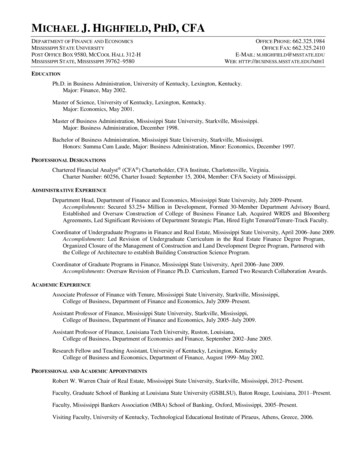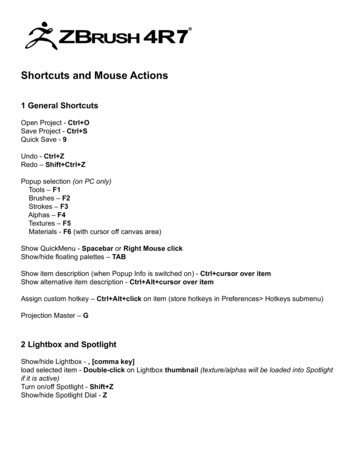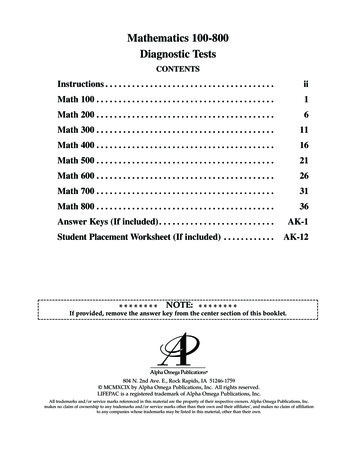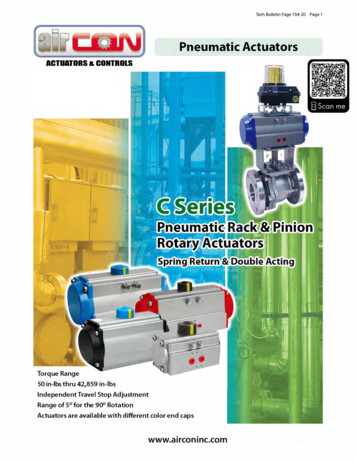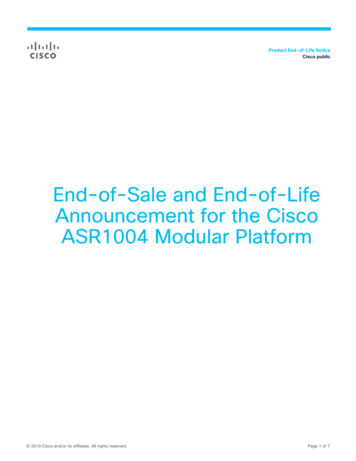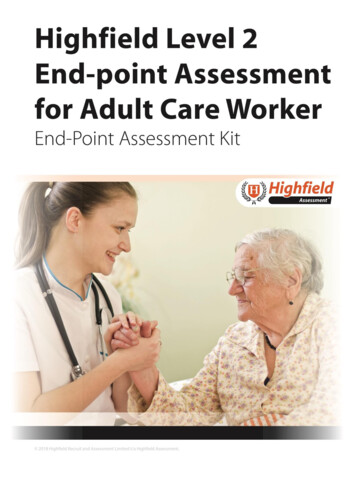
Transcription
Highfield Level 2 End-Point Assessment forAdult Care WorkerEPA-KitContentsPlease click on the headings below to navigate to the associated section of the EPA kit.Introduction. 5The Highfield Approach . 8Gateway . 11The Adult Care Worker Apprenticeship Standard . 14Assessment Summary . 50Assessing the Situation Judgement Test . 54Assessing the Professional Discussion . 62ACW 2.0 ST0005: AP022
How to use this EPA KitWelcome to the Highfield End-Point Assessment Kit for the Adult Care WorkerApprenticeship Standard.Highfield is an independent end-point assessment organisation that has been approved tooffer and carry out the independent end-point assessments for the Level 2 Adult CareWorker Apprenticeship Standard. Highfield internally quality assures all end-pointassessments in accordance with its IQA process, and additionally all end-point assessmentsare externally quality assured by the relevant EQA organisation.The EPA kit is designed to outline all you need to know about the end-point assessments forthis standard and will also provide an overview of the on-programme delivery requirements.In addition, advice and guidance for trainers on how to prepare apprentices for the endpoint assessment is included. The approaches suggested are not the only way in which anapprentice may be prepared for their assessments, but trainers may find them helpful as astarting point.Highfield also offer the Highfield Adult Care Worker Apprenti-kit, which is a comprehensivelearning resource designed to be used on-programme.For more information, please go to the Highfield Products website. Please note that use ofthis kit is not a prerequisite for apprentices undertaking the adult care worker end-pointassessment.Key factsApprenticeship standard:Level:On Programme Duration:Grading:End-Point Assessment methods:ACW 2.0 ST0005: AP02Adult Care Worker2Typically 12-18 monthsPass/merit/distinctionSituational judgement test, professional discussion3
In this kit, you will find: an overview of the standard and any on-programme requirementsa section focused on delivery, where the standard and assessment criteria arepresented in a suggested format that is suitable for deliveryguidance on how to prepare the apprentice for gatewaydetailed information on which part of the standard is assessed by whichassessment methodsuggestions on how to prepare the apprentice for each part of the end-pointassessmenta section focused on the end-point assessment method where the assessmentcriteria are presented in a format suitable for carrying out ‘mock’ assessmentsACW 2.0 ST0005: AP024
IntroductionStandard overviewTo work in care is to make a positive difference to someone’s life when they are faced withphysical, practical, social, emotional or intellectual challenges. Adult care workers need tohave the right values, behaviours, competences and skills to provide high qualitycompassionate care and support. They are the frontline staff who help adults with care andsupport needs to achieve their personal goals and live as independently and safely aspossible, enabling them to have control and choice in their lives, which is at the heart ofperson-centred care. Job roles are varied and determined by, and relevant to, the type ofservice being provided and the person supported. Adult care workers may work inresidential or nursing homes, domiciliary care, day centres or some clinical healthcaresettings. This standard covers both adult care workers and personal assistants. Personalassistants do the same job as an adult care worker and work directly for 1 individual usuallywithin their own home. Working with people, feeling passionate about supporting andenabling them to live a more independent and fulfilling life is a rewarding and worthwhilejob that provides excellent career opportunities.On-programme requirementsApprentices must undertake a programme of study in a suitable care setting and completethe Care Certificate as part of a high-quality induction programme. The Care Certificate,which builds on the previous Common Induction Standards (CIS) and National MinimumTraining Standards, is a requirement for all apprentices on this standard. For those staff whohave completed the CIS prior to the launch of the Care Certificate, it is the employer’sresponsibility to judge where the skills gaps are that staff need to fill to meet the additionalstandards in the Care Certificate. The Level 2 Diploma in Care (England) is completed withthe support of a learning provider or employer who trains apprentices. Apprentices can onlyattempt the separate, mandatory end-point assessment once the recognised diploma andCare Certificate have been attempted and achieved. Apprentices must also undertake theEnhanced Disclosure and Barring Service process and provide the result to their employerprior to starting their apprenticeship. The apprentice should also receive support with: Ongoing assessment by the employer and provider – for example meetings withapprentice, employer and learning provider, observations of workplace, gatheringevidence etc.Completion of the self-assessment exerciseACW 2.0 ST0005: AP025
Additional, relevant on-programme qualificationThe required on-programme regulated qualification for this apprenticeship is the Level 2Diploma in Care (England)Readiness for end-point assessmentIn order for an apprentice to be ready for the end-point assessments: the Level 1 English and mathematics components of the apprenticeship must besuccessfully completed by the apprentice, with level 2 English and mathematicsbeing attempted 15 standards of the care certificate must be successfully achieved by the apprentice following completion of the diploma, collate testimonies (minimum of 1) frompeople who use services. This must also be submitted to the end-point assessor tosupport the professional discussion. the apprentice should undertake a self-assessment in the last month of theirapprenticeship to enable them to see whether they are confident that they havetaken on board all aspects of the occupation. This self-assessment must besubmitted to the independent end-point assessor as a source of evidence to preparefor the professional discussion. the required on-programme qualification, the Level 2 Diploma in Care must havebeen achieved the line manager (employer) must be confident that the apprentice has developedall the knowledge, skills and behaviours defined in the apprenticeship standard andthat the apprentice is competent in performing their role. To ensure this, theapprentice must attend a formal meeting with their employer to complete thegateway readiness report. the apprentice and the employer should then engage with Highfield Assessment toagree a plan and schedule for each assessment activity to ensure all components canbe completed. Further information about the gateway process is covered later in thiskit.Order of end-point assessmentsThe situational judgement test must be the first assessment component, followed by theprofessional discussion.ACW 2.0 ST0005: AP026
The professional discussion can only be attempted after the situational judgement test hasbeen completed to at least a pass grade.The apprentice is required to complete and achieve a minimum of a pass in both of the endpoint assessment components as above in addition to achieving the prerequisitecomponents. A pass will be considered as the minimum attainment to achieve an apprenticecertificate.Click here to return to contentsACW 2.0 ST0005: AP027
The Highfield ApproachThis section describes the approach Highfield has adopted in the development of this endpoint assessment in terms of its interpretation of the requirements of the end-pointassessment plan and other relevant documents.Documents used in developing this end-point assessmentApprenticeship Standard for Adult Care Worker sessment plan for adult care worker (ST0005/AP02, Adult Care Worker Assessment Planv1.1 org/media/4727/st0005 adultcareworker l2 apforpublication revision feb-2018.pdf)Adult Care Handbook for End-Point Assessment V4 (March 2019)Specific ConsiderationsIn order to develop valid end-point assessments, Highfield has interpreted the requirementsof the Adult Care Worker assessment plan as follows: knowledge parts of the standard are assessed via the situational judgement test. skills and behaviours within the standard are assessed through professionaldiscussion, with coverage of the relevant skills inferred from demonstration of theskills from supporting information provided through testimonies and selfassessment. Highfield Assessment has provided indicative assessment criteria and amplificationfor the knowledge and skills requirements within this EPA Kit. This is provided asfurther guidance to support the apprentice in preparation for end-point assessment.In the end-point assessments, the apprentice will be assessed on the high-leveloutcomes within the standard and not the indicative criteria provided as guidancewithin this EPA Kit. The adult care worker standard mentions that testimonies from users of servicesshould be collected in the 3 months leading to Gateway. Highfield Assessment hasincluded testimonies from users of services as one of the pre-requisites at Gateway.ACW 2.0 ST0005: AP028
These should be submitted with all Gateway documentation to Highfield Assessmentand will be used to support the professional discussion.There are likely to be occasions when it is difficult to obtain testimonies from usersof services, for example, if the individual does not have the capacity to provide thisor if they do not give their consent. Respecting privacy and choice must take priorityin these situations and therefore it may be necessary to see if there are alternativeways of obtaining testimonies. Such as, if the individual has an advocate, familymember or other representative that would be willing to provide a testimony on theindividual’s behalf with the consent of the individual. For example, a family membercould either provide a testimony from the perspective of the individual, on theindividual's behalf OR the family member could provide a testimony from their ownperspective on behalf of the individual.If it is not possible to obtain the examples above, consideration can be given toothers providing support for the individual (e.g. a social worker etc.). Managers maybe used as a last resort, if all other possibilities have been explored. In all cases,where apprentices are submitting anything other than a ‘direct’ service usertestimony, a statement must be made outlining why and what evidence has beensubmitted at gateway. The end-point assessment plan states that the professional discussion will be astructured discussion between the apprentice and the end-point assessor. Theemployer may be present, to support, but not lead the apprentice and to confirminformation, at the assessor’s request. The employer will not be allowed to add any further information or examples towhat the apprentice has stated or lead them in any way. Highfield would encouragethe employer/training provider and the apprentice to plan for the professionaldiscussion and consider what resources they may bring with them to support themduring their professional discussion. All evidence must be the apprentice’s own workand will only be used to support their discussion. Grading the professional discussion – Highfield provide the following guidance tosupport apprentices to achieve higher than a pass grade for the professionaldiscussionTo achieve a pass, the apprentice must demonstrate that they have achieved all theelements for this assessment method.ACW 2.0 ST0005: AP029
Merit grade will be given to apprentices who are able to engage in and actively takeforward their professional discussion. They are able to demonstrate an insight inapplying the knowledge, skills, and behaviours set out in the standard consistentlyand in a range of situations. Apprentices are able to reflect on some aspects of theirpractice.Distinction grade will be given to apprentices who are able to engage in aprofessional discussion that demonstrates an exceptional understanding andapplication of the knowledge, skills and behaviours of the standard. Responsesdemonstrate consistent knowledge of relevant concepts and theories when appliedto their own practice. Apprentices are able to demonstrate skills of a reflectivepractitioner.Resit and retake guidance in this EPA Kit has been produced to be consistent withthe additional guidance provided by the EQAO and in the Adult Care Handbook forEnd Point Assessment.Click here to return to contentsACW 2.0 ST0005: AP0210
GatewayHow to prepare for gatewayAfter apprentices have completed their on-programme learning, they should be ready topass through ‘gateway’ to end-point assessment.Gateway is a meeting that should be arranged between the apprentice, employer andtraining provider to determine that the apprentice is ready to undertake their end-pointassessment. The apprentice should prepare for this meeting by bringing along work-basedevidence including: customer feedbackrecordingsmanager statementswitness statementsAs well as evidence from others, such as: mid and end-of-year performance reviewsfeedback to show how they have met the apprenticeship standards while onprogrammeIn advance of gateway, apprentices will need to have: achieved Level 1 Englishachieved Level 1 mathematicsattempted Level 2 English and mathematicsachieved the 15 standards as set out in the Care Certificateachieved the Level 2 Diploma in Care (England)undertaken a self-assessment in the last month of their apprenticeship to enablethem to see whether they are confident that they have taken on board all aspects ofthe occupation. This self-assessment must be submitted to the independent endpoint assessor as a source of evidence to prepare for the professional discussioncollected testimonies from people who use services in the last 3 months of theapprenticeship, following completion of the diploma. The testimonies must besubmitted to the end-point assessor and will be used to support the professionaldiscussion.ACW 2.0 ST0005: AP0211
Therefore, apprentices should be advised by employers and providers to gather thisevidence throughout their on-programme training unless it is specified above e.g. selfassessment and testimonies from users of services. It is recommended that employers andproviders complete regular checks and reviews of this evidence to ensure the apprentice isprogressing and achieving standards before the formal gateway meeting is arranged.The gateway meetingThe gateway meeting should last around an hour and must be completed on or after theapprenticeship on-programme end date. It should be attended by the apprentice and therelevant people who have worked with the apprentice on-programme, such as the linemanager/employer or mentor, the on-programme trainer/training provider and/or a seniormanager (as appropriate to the business).During the meeting, the apprentice, employer and training provider will discuss theapprentice’s progress to date and confirm if the apprentice has met the full criteria of theapprenticeship standard during their on-programme training. The Gateway Readiness Reportshould be used to log the outcomes of the meeting and agreed by all 3 parties. This report isavailable to download from the Highfield Assessment website.The report should then be submitted to Highfield to initiate the end-point assessmentprocess.If you require any support completing the Gateway Readiness Report, please contactyour Employer Engagement Manager at Highfield Assessment.Please note: a copy of the standard should be available to all attendees during the gatewaymeeting.Reasonable adjustments and special considerationsHighfield Assessment has measures in place for apprentices who require additional support.Please refer to the Highfield Assessment Reasonable Adjustments Policy for furtherinformation/guidance.ID requirementsHighfield Assessment will need to ensure that the person undertaking an assessment isindeed the person they are claiming to be. All employers are therefore required to ensurethat each apprentice has their identification with them on the day of the assessment so theend-point assessor can check.ACW 2.0 ST0005: AP0212
Highfield Assessment will accept the following as proof of an apprentice’s identity: a valid passport (any nationality)a signed UK photocard driving licencea valid warrant card issued by HM forces or the policeanother photographic ID card, e.g. employee ID card, travel card, etc.Click here to return to contentsACW 2.0 ST0005: AP0213
The Adult Care Worker Apprenticeship StandardThe following pages contain the Adult Care Worker Apprenticeship Standard and indicativeassessment criteria in a suggested format that is suitable for delivery. The behaviours andpersonal attributes expected of adult care workers, the 6Cs, are listed at the end, and it isanticipated apprentices will be introduced to these behaviours throughout theirprogramme.ACW 2.0 ST0005: AP0214
The job they have to do, their main tasks and responsibilitiesKnowledge – Situational Judgement TestThe apprentice will know and understand:KA1 - The tasks and responsibilities of the job rolerelevant to the context of the service in which theyare working. This could include supporting withsocial activities, monitoring health, assisting witheating, mobility and personal care.Indicative assessment criteria:K1.1 Describe tasks and responsibilities of own roleK1.2 Outline how own role fits within the structure and context of theorganisationKA2 - Professional boundaries and limits of theirtraining and expertiseK1.3K1.4Describe the importance of professional boundaries in adult careOutline limits of responsibility based on own training and expertiseKA3 - Relevant statutory standards and codes ofpractice for their roleK1.5K1.6Identify statutory standards that influence own roleDescribe how statutory standards and codes of practice influence own roleKA4 - What the ‘duty of care’ is in practiceK1.7K1.8K1.9Define duty of careDescribe how duty of care relates to duty of candourExplain how duty of care affects own roleKA5 - How to contribute towards the developmentand creation of a care plan underpinned by theindividual’s preferences in regard to the way theywant to be supportedK1.10 Explain the importance of using an individual care planK1.11 Describe how to contribute to the development of an individual’s careplanK1.12 Describe how to find out the individual’s preferences in relation to theway they want to be supportedACW 2.0 ST0005: AP0215
KA6 - How to identify, respond to and escalatechanges to physical, social, and emotional needs ofindividualsK1.13 List physical, social and emotional needs of individualsK1.14 Explain how to identify, respond to and escalate changes to physical, socialand emotional needs of individualsKA7 - How to access, follow and be compliant withregulations and organisational policies andproceduresK1.15 Outline how to access regulations and organisational policies andproceduresK1.16 Explain how regulations and organisational policies and procedures areimplemented in own roleAmplification and guidanceTasks and responsibilities:This could include supporting with social activities, monitoring health, assisting with eating, mobility and personal careStatutory standards:This could include: Codes of practice Regulations Minimum standards National occupational standards Care CertificateDuty of care:Duty of care means that a worker must aim to provide high quality care to the best of their ability and say if there are any reasons whythey may be unable to do so.Individual’s care plan:A care plan may be known by other names e.g. support plan, individual plan. It is the document where day to day requirements andpreferences for care and support are detailed.ACW 2.0 ST0005: AP0216
Individual refers to someone requiring care or support; it will usually mean the person or people supported by the apprentice.ACW 2.0 ST0005: AP0217
The importance of having the right values and behavioursKnowledge – Situational Judgement TestThe apprentice will know and understand:KB8 - How to support and enable individuals toachieve their personal aims and goalsIndicative assessment criteria:K2.1 Define person centred valuesK2.2 Explain the importance of working in a way that embeds personcentred valuesK2.3 Explain why risk-taking can be part of a person-centred approachK2.4 Explain how to work in a way that supports and enables individuals toachieve their personal aims and goalsKB9 - What dignity means in how to work withindividuals and othersK2.5Explain how to promote dignity in own role with individuals and othersKB10 - The importance of respecting diversity andtreating everyone equallyK2.6Explain what is meant by: Diversity Equality Inclusion DiscriminationIllustrate the importance of respecting diversity and promoting equalityGive examples of practices that respect diversity and promote equalityK2.7K2.8ACW 2.0 ST0005: AP0218
Amplification and guidancePerson centred values include: Individuality Rights Choice Privacy Independence Dignity Respect Care Compassion Courage Communication Competence PartnershipOthers:Could include your own colleagues and other professionals across health and social care.ACW 2.0 ST0005: AP0219
The importance of communicationKnowledge – Situational Judgement TestThe apprentice will know and understand:KC11 - The barriers to communicationIndicative assessment criteria:K3.1 Identify barriers to communicationK3.2 Give examples of ways to reduce barriers to communicationK3.3 Describe ways to check that communication has been understoodK3.4 List sources of information, support and services to enable communicationwith individuals and othersKC12 - The impact of non-verbal communicationK3.5K3.6K3.7KC13 - The importance of active listeningK3.8 Define active listeningK3.9 Explain how to use active listening in own roleK3.10 Explain the importance of active listeningKC14 - How the way they communicate can affectothersKC15 - About different forms of communication e.g.signing, communication boards etcK3.11 Assess how own communication can affect individuals and othersKC16 - How to find out the best way to communicatewith the individual they are supportingKC17 - How to make sure confidential information iskept safeK3.14 Describe methods of communication used to meet individuals’communication needs, wishes and preferencesK3.15 Define the term ‘confidentiality’K3.16 Identify legislation and agreed ways of working in relation to theconfidential handling of informationK3.17 Describe ways of handling confidential informationACW 2.0 ST0005: AP0220List types of non-verbal communicationGive examples of situations when non-verbal communication is usedExplain the impact of using non-verbal communication methods tosupport individualsK3.12 Describe different ways that individuals communicateK3.13 Describe how to establish individuals’ communication and language needs,wishes and preferences
Amplification and guidanceServices may include: Translation services Interpreting services Speech and language services Advocacy servicesNon-verbal communication may include: Position/proximity Eye contact Touch Signs Symbols and pictures Physical gestures Body language Behaviour Writing Objects of reference Human and technological aidsPreferences may be based on: Beliefs Values CultureMethods of communication may be: VerbalACW 2.0 ST0005: AP0221
Non-verbalHumanTechnologicalLegislation may include: Data Protection Act Human Rights Act Mental Capacity ActAgreed ways of working:This refers to organisational policies and procedures. This includes those less formally documented by individual employers and the selfemployed or formal policies.ACW 2.0 ST0005: AP0222
How to support individuals to remain safe from harm (Safeguarding)Knowledge – Situational Judgement TestThe apprentice will know and understand:KD18 - What abuse is and what to do when theyhave concerns someone is being abusedKD19 - The national and local strategies forsafeguarding and protection from abuseIndicative assessment criteria:K4.1 Define different types of abuseK4.2 List the signs and symptoms of different types of abuseK4.3 Describe factors that may contribute to an individual being morevulnerable to abuseK4.4 Explain the actions to take if there are concerns that an individual is beingabusedK4.5 Explain the actions to take if an individual alleges that they are beingabusedK4.6 State ways to ensure evidence of abuse is preservedK4.7 Outline national policies for safeguarding and protection from abuseK4.8 Outline local strategies for safeguarding and protection from abuseKD20 - What to do when receiving comments andcomplaintsK4.9KD21 - How to recognise unsafe practices in theworkplaceK4.11 Give examples of unsafe practices that may affect the wellbeing ofindividualsK4.12 Explain the actions to take if unsafe practices have been identifiedK4.13 Explain the actions to take if unsafe practices have been reported butnothing has been done in responseK4.14 Define the term whistleblowingK4.15 Assess the importance of whistleblowing in adult careK4.16 Describe the process for whistleblowingKD22 - The importance and process ofwhistleblowingACW 2.0 ST0005: AP0223Describe the importance of an accessible complaints procedure forreducing the likelihood of abuseK4.10 Explain the actions to take when receiving comments and complaints
KD23 - How to address any dilemmas they may facebetween a person’s rights and their safetyK4.17 Give examples of dilemmas that may be faced between a person’s rightsand their safetyK4.18 Describe how to address dilemmas that may be faced between a person’srights and their safetyAmplification and guidanceAbuse includes: Physical abuse Domestic violence – this should include acts of control and coercion Sexual abuse Psychological abuse Financial/material abuse Modern slavery Discriminatory abuse Organisational abuse Neglect/acts of omission Self-neglectAbuse may be covert and subtle as well as overt.Factors may be internal or external to the individual.Actions to take constitute the worker’s responsibilities in responding to allegations or suspicions of abuse.Local strategies may include: Employer/organisational policies and procedures Multi-agency adult protection arrangements for a locality The roles of different agencies in safeguarding and protecting individuals from abuseACW 2.0 ST0005: AP0224
Unsafe practices may include: Poor working practices Resource difficulties Operational difficulties Restrictive practicesWellbeing may include aspects that are: Social Emotional Cultural Spiritual Intellectual EconomicWhistleblowing:Whistleblowing is when a worker reports suspected wrongdoing at work. Officially this is called “making a disclosure in the publicinterest” and may sometimes be referred to as “escalating concerns.” You must report things that you feel are not right, are illegal or ifanyone at work is neglecting their duties. This includes when someone’s health and safety is in danger; damage to the environment; acriminal offence; that the company is not obeying the law (like not having the right insurance); or covering up wrongdoing.ACW 2.0 ST0005: AP0225
How to promote health and wellbeing for the individuals they support and work colleaguesKnowledge – Situational Judgement TestThe apprentice will know and understand:KE24 - The health and safety responsibilities of self,employer and workersIndicative assessment criteria:K5.1 Outline legislation and regulations relating to health and safety in adultcareK5.2 Describe responsibilities for health and safety of: Self Employer Worker Others in the work settingKE25 - How to keep safe in the work environmentK5.3K5.4K5.5KE26 - What to do when there is an accident orsudden illnessK5.6K5.7KE27 - What to do with hazardous substancesK5.8KE28 - How to promote fire safetyACW 2.0 ST0005: AP0226Describe agreed ways of working for health and safetyList health and safety tasks that should only be carried out with specialisttrainingOutline sources of information, guidance and support relating to health andsafetyDescribe types of accidents or sudden illness that may occurOutline the procedures to be followed if an accident or sudden illnessshould occurIdentify hazardous substances and materials that may be found in adultcareK5.9 Outline safe practices for: Storing hazardous substances and materials Using hazardous substances and materials Disposing of hazardous substances and materialsK5.10 Describe how to prevent fires from starting or spreadingK5.11 Outline what to do in the event of a fire
KE29 - How to reduce the spread of infectionK5.12 Identify the roles and responsibilities in the prevention and control ofinfectionK5.13 Describe the causes and spread of infectionK5.14 Describe ways to reduce the spread of infectionK5.15 Outline ways to ensure that own health and hygiene does not pose a risk toothersKE30 - What a risk assessment is and how it can beused to promote person centred care safelyK5.16 Outline the difference between a hazard and a riskK5.17 Explain the purpose of risk assessm
The situational judgement test must be the first assessment component, followed by the professional discussion. ACW 2.0 ST0005: AP02 7 . The adult care worker standard mentions that testimonies from users of services . where apprentices are submitting anything other than a 'direct' service user testimony, a statement must be made .


